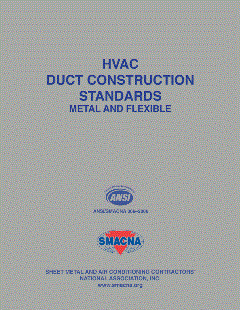HVAC construction inventor has alternative to traditional ductwork fabrication
An inventor says he has come up with an ideal replacement for traditional ductwork.












A Massachusetts man says he has the solution for one of the top causes of HVAC system inefficiency: air leakage from sheet metal ductwork.
His solution: Get rid of the sheet metal.
David Carpinetti, a former master plumber and HVAC installer, wants to replace almost all the sheet metal used in HVAC construction with an insulated recycled plastic compound similar to what’s commonly used in plumbing. He calls it Black Duct and his company is Black Duct Industries Inc.
“We have a game-changing product,” the 59-year-old West Brookfield, Mass., resident says. “We are literally going to change the industry.”
Most sheet metal ductwork used in buildings is based on 100-year-old technology, Carpinetti says. It leaks air out, allows contaminants in and takes too long to make and install. He says his invention — easy to clean and quick to assemble — eliminates all those problems.
Instead of performing ductwork fabrication in a sheet metal works shop, the patented Black Duct is premade and shipped flat, ready to install. Duct wrap and sealer is not required, since the product comes with 2-inch fiberglass insulation with a built-in R-value of 8.7.
“My stuff is integral, so the insulation will never break down,” Carpinetti says. “It’s going to maintain its R-value. It’s not going to deteriorate. It’s going to maintain its performance throughout the life of the duct.”
Easier to install
And compared with the skills needed for traditional HVAC construction, he says putting up plastic Black Duct is far easier.
“A lot of the pieces will be ready out of the box,” he says. “Absolutely nothing is metal. It’s all glued together, so you don’t have any leaks.”
Carpinetti estimates that the time required to erect traditional HVAC market systems using sheet metal products could be cut in half by using his plastic ductwork.
With a product that he says could replace the billions of pounds of sheet metal that are used in HVAC systems around the world, Carpinetti acknowledges the product might scare some people.
“A lot of the sheet metal contractors I talk to say, ‘Wait, wait, wait. Hold on a minute. You’re going to put us out of business.’ No I am not,” he says. “All they’re going to do is change material. You still need to install ductwork. You still need to have it. Your sheet metal fabrication shops can go out and buy a $400 table saw and start making my stuff real easy.
“Nobody is losing any business,” he adds. “Instead of using sheet metal, they’ll (be) using my Black Duct.”
Carpinetti says he got the idea for an insulated plastic duct product about 18 years ago when he cut his thumb while installing metal ductwork.
“Everybody in a sheet metal apprenticeship has been sliced to ribbons more than once,” he says. He figured there had to be a better material.
Unanticipated setbacks
But getting his company started and the product into contractors’ hands turned out to be much more difficult than Carpinetti anticipated. He seems to have a knack for picking the wrong time to launch his venture.
He first patented his product in May 2001 and drew up a business plan that September — right before terrorists sent two passenger planes into the World Trade Center in New York City. The resulting recession, although short-lived, was enough to prevent him from securing money to finance the product’s introduction.
He tried again in the mid-2000s, traveling several times to Vietnam and meeting with businessmen who Carpinetti says were eager to invest in Black Duct. He says he even had manufacturing facilities there ready to make the product. Then the Great Recession hit.
“The only problem I have is bad timing,” he says. “Absolutely horrible.”
That’s why he acknowledges that sheet metal forming machinery makers and sellers of sheet metal products don’t have much to worry about from his startup company just yet.
“My product is not allowed to be installed in this country, due to the building codes,” he says.
Most U.S. construction regulations require ductwork to maintain its integrity at up to 250°F.
“We don’t meet that criterion — we start to deflect around 198 degrees,” Carpinetti says. “That’s nowhere near 250. But I question the 250 temperature written into the code. Where the hell did that come from?”
Looking abroad
So he’s again turning his attention overseas to places like the Caribbean and Asia, which don’t have the same requirements, he says.
“We’re planning on selling elsewhere and the hell with the United States as far as I’m concerned right now because they have too many regulations in place,” he says.
Figuring he needs about $300,000 immediately to get Black Duct Industries going, Carpinetti turned to Kickstarter.com, the crowdfunding website that has helped successfully bankroll everything from watchmakers to movies. But an HVAC product proved to be a hard sell for the site’s visitors and the campaign failed.
The Kickstarter campaign’s lack of success didn’t surprise — or faze — Carpinetti.
“Our product is not a homeowner product,” he says. “The other reason I did it was for the exposure.”
And on that scale, Carpinetti says the campaign was a success. He was featured in his hometown newspaper and was also interviewed by an online men’s technology magazine.
He estimates that it will take $11 million to make and market Black Duct on a large scale. But Carpinetti is undaunted and says he is committed to the product. More inventions are on the way, he adds.
“There’s a lot of buzz going on,” he says.
More information on Carpinetti and his product is available www.BlackDuctIndustriesInc.com.
For reprints of this article, contact Renee Schuett at (248) 786-1661 or email schuettr@bnpmedia.com
















